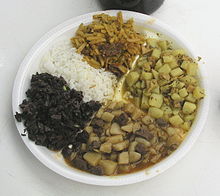Charqui
Charqui (Spanish) or Charque (Portuguese), also Jerky (English), from the Quechua -word Charki borrowed "dried meat" for is that in South America usual preparation of dried meat from salted, cut into thin slices or strips of meat. Today it is mostly beef . The use of llama , guanaco , sheep , goat , pig , horse , game meat, and others is also common.
history
Historians attribute the origin of this method to the Indians in Peru , who used this method centuries ago to preserve an excess of game. In the times of the Inca Empire , travelers could buy dried llama meat in rest houses ( tambos ) along the Inca roads . During its production, not only the strong effects of the sun were used, but also the coldness of the mountain air ( freeze-drying ). In general, because of its nutritiousness , charqui was one of the staple foods of the hard-working rural population and miners in the colonial times of South America , and of the slaves in Brazil and the Caribbean .
preparation
Traditionally, the meat was cut into strips as thin as possible, removing most of the fat and blood to reduce the moisture content. Then the meat was hung up in airy, dry and above all sunny places until the strips had the consistency of cardboard or leather. Nets were set up to protect against flies. Once the drying was complete, the meat was placed in a clay oven to bake. Sometimes the mere drying was supplemented by smoking . Finally, the meat was kept in containers between layers of salt, occasionally seasoning it with pepper , ground paprika and garlic . Charqui was rarely preserved in honey and propolis .
Today, charqui from beef - similar to the US beef jerky - is also produced in large industrial plants, the saladeros (in Uruguay and Argentina ) and the charqueadas in southern Brazil. There, on the Rio Grande do Sul , the production of charque has developed into one of the most important economic sectors in the region since the 19th century. However, the meat is not cut into strips there, but in thin blankets (manta rays) . It is salted first and then hung in large, airy sheds. In contrast to carne de sol (meat dried in the sun), it is not exposed to direct sunlight. Because of the relatively humid climate, a greater use of salt is necessary for preservation, which means that the charque is increasingly approaching the cured meat .

consumption
Charqui can be consumed without any further preparation. Usually, the meat is soaked beforehand and cooked in stews - with pumpkin , corn , beans and potatoes as Locro or Charquicán in Chile, together with Olluco as Olluquito in Bolivia and Peru . In Brazil, the feijoada with charque, beans and other garnishes is the national dish . It is also used to fill dumplings - for example in empanadas and tamales . In eastern Bolivia, it is not only cooked, but also fried. There are also cooked and mashed cassava or plantains .
Web links
- Charque, carne de sol, carne seca - different types of dried meat (Portuguese)
- Traditional preparation of charqui in Argentina
- Charqui on mundoandino.com (English)
